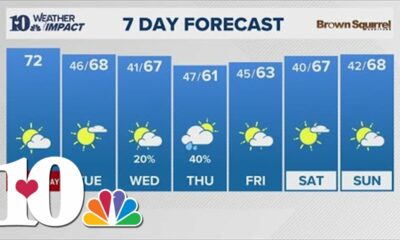Kaiser Health News
California’s Homelessness Crisis Is Homegrown, Study Finds
by Angela Hart
Tue, 20 Jun 2023 09:00:00 +0000
SACRAMENTO, Calif. — California’s homelessness crisis is a homegrown problem that is deepening amid a shortage of affordable housing and emergency shelter, and it’s often the brutal conditions of living on the street that trigger behavioral health problems, such as depression and anxiety, researchers found in a comprehensive study on homelessness.
The new findings by leading researchers at the University of California show that at least 90% of adults who are experiencing homelessness in the state became homeless while living in California.
“This idea that homeless people are rushing into California is just not true,” said Margot Kushel, a physician who treats homeless people and the lead investigator of the study for the UC-San Francisco Benioff Homelessness and Housing Initiative. “There’s so much myth-making around this magnet theory that people who are homeless flock to California, but this is our own problem.”
“These are our own policies,” Kushel added, referring to the state and federal governments. “We did this to people.”
An estimated 172,000 people are homeless in California, the largest homeless population of any state in the U.S. and 30% of the nation’s total, even though California has just 12% of the population. Researchers believe the way the state measures homelessness, though important, represents an undercount because cities and counties tallying their homeless populations in just one day miss people who may be hidden and living in their cars, for instance.
The homelessness study went further than annual point-in-time counts by analyzing the experiences of 3,200 homeless adults age 18 and older from October 2021 to November 2022, then conducted in-depth interviews with some participants to gain a better understanding of the state’s overall crisis.
California Health and Human Services Secretary Mark Ghaly, who asked for an analysis of the state’s homelessness crisis, said the findings underscore where it must improve. The study could inform the state’s approach to expanding its behavioral health system.
“As we drive toward addressing the health and housing needs of Californians experiencing homelessness, this study reinforces the importance of comprehensive and integrated supports,” Ghaly said in a statement. “California is taking bold steps to address unmet needs for physical and behavioral health services, to create a range of housing options that are safe and stable, and to meet people where they are.”
Democratic Gov. Gavin Newsom and state health officials are steering initiatives that include a 2024 ballot measure to expand treatment for mental health and addiction, including building more residential treatment facilities. Newsom is also leading a new program under the Community Assistance, Recovery and Empowerment Act, known as CARE courts, to move people into court-ordered treatment. And the administration is seeking to add rent payments as a health care benefit available to low-income Californians on Medi-Cal.
Kushel said the findings point to the increasing demands for adequate mental health and addiction treatment — and more low-income housing. While some people reported heightened mental health and substance use problems before becoming homeless, the trauma of being on the streets, Kushel said, can lead to, or amplify, behavioral health conditions, including drug use and depression.
A staggering 82% of people experiencing homelessness said they had a mental health condition or substance use challenge in their lifetime. And 66% said they were currently experiencing mental health problems, such as depression, anxiety, hallucinations, or trouble remembering things.
“I think that speaks to the despair that people experience,” Kushel said.
Sage Johnson, 28, was homeless in Los Angeles and lived for years in shelters before getting into low-income housing. Despite working graveyard shifts at Walgreens and other minimum-wage jobs at the time, she said, she couldn’t find anything affordable and experienced heightened depression and anxiety while homeless.
“Being out there unmedicated, without therapy, you spiral out of control,” Johnson said, who was among the formerly homeless who helped guide the research.
The report also found:
- Of California’s adult homeless population, 75% became homeless in their county of residence. Nearly 40% reported being homeless for the first time.
- The median length of homelessness was 22 months. In the six months before becoming homeless, people had earned a median monthly income of $960.
- Roughly 1 in 5 became homeless after leaving an institution such as jail. Most people, 78%, reported spending the most time homeless in the prior six months in unsheltered settings: 21% in a vehicle, 57% without a vehicle.
- Before experiencing homelessness, 32% had a mortgage or rental lease agreement; roughly 50% did not.
- Researchers believe many unhoused people have encountered violence, contributing to the crisis: 72% reported physical violence in their lifetime and 24% said they had experienced sexual violence. Sexual violence was more common among women and transgender or nonbinary individuals.
- The homeless population is aging; 47% of all adults surveyed were 50 or older. And Black and Native Americans are disproportionately homeless. For example, just 6% of the state’s population is Black, yet 26% of homeless people surveyed identified as Black.
The findings show the limits of California’s unprecedented spending to combat its homelessness crisis. Newsom’s administration has poured more than $20 billion into the crisis since he took office in 2019, much of that distributed to local governments to provide services and build housing.
That’s on top of billions the state is pouring into improving its mental health system and a $12 billion social services-based initiative called CalAIM, which offers housing security deposits and sobering centers to help vulnerable populations, including homeless people.
But the study found that expanding health coverage and adding social services isn’t serving all those in need. Specifically, 83% of homeless people surveyed said they had health insurance mostly through Medi-Cal, California’s Medicaid program for low-income people. Yet more than half relied on the emergency room for care and nearly a quarter said they couldn’t access the care they needed. A majority who said they were experiencing mental health problems either weren’t being treated or got care through emergency rooms.
In some ways, the policies Newsom is steering may make the problem worse. For example, his administration has backed removing homeless encampments in exchange for shelter and services. But homeless people say those promises are often unmet.
Forced displacement, the report found, and confiscation of belongings when clearing encampments can hurt the state’s ability to find housing for people, Kushel said.
“It sometimes feels like one part of government is working against the other part,” she said. “We’re frantically trying to get people their documents so they can move into housing, and then somebody else throws it all away. That’s not helpful.”
This article was produced by KFF Health News, which publishes California Healthline, an editorially independent service of the California Health Care Foundation.
By: Angela Hart
Title: California’s Homelessness Crisis Is Homegrown, Study Finds
Sourced From: kffhealthnews.org/news/article/california-homelessness-is-homegrown-university-of-california-research/
Published Date: Tue, 20 Jun 2023 09:00:00 +0000
Did you miss our previous article…
https://www.biloxinewsevents.com/doctor-lands-in-the-doghouse-after-giving-covid-vaccine-waivers-too-freely/
Kaiser Health News
As California Taps Pandemic Stockpile for Bird Flu, Officials Keep Close Eye on Spending
SUMMARY: California is using state and federal stockpiles to provide up to 10,000 farmworkers with safety gear as the state reports 21 human cases of bird flu. The state began distributing protective equipment in May and has confirmed bird flu at over 270 dairies. Drawing lessons from the COVID-19 pandemic, California is improving emergency responses and maintaining a stockpile that includes millions of face masks. However, due to financial constraints, funding for disaster supplies has been cut, and some preparedness programs were reduced or eliminated. A ballot measure to increase pandemic preparedness funding failed after its key financial supporter was convicted.
The post As California Taps Pandemic Stockpile for Bird Flu, Officials Keep Close Eye on Spending appeared first on kffhealthnews.org
Kaiser Health News
After Congress Ended Extra Cash Aid for Families, Communities Tackle Child Poverty Alone
SUMMARY: Dr. Mona Hanna, a pediatrician in Flint, Michigan, is championing the Rx Kids program, a pioneering cash aid initiative that provides $1,500 mid-pregnancy and $500 monthly for a child’s first year to Flint families. Since its January launch, nearly all babies born in Flint are enrolled, aiding parents with essential needs like diapers and food. While Rx Kids aims to reduce poverty and inspire lawmakers and donors, challenges remain for expansion in underserved regions like Michigan’s Upper Peninsula, where substantial private funding is needed. Ongoing efforts seek to raise awareness and secure resources for this impactful program.
The post After Congress Ended Extra Cash Aid for Families, Communities Tackle Child Poverty Alone appeared first on kffhealthnews.org
Kaiser Health News
California Dengue Cases Prompt Swift Response From Public Health Officials
SUMMARY: Jason Farned and his team at the San Gabriel Valley Mosquito and Vector Control District have been preparing for dengue’s arrival, with the virus now detected in California. The spread of Aedes mosquitoes, capable of transmitting dengue, has been fueled by climate change and international trade. In 2023, California saw 13 locally acquired cases, prompting efforts like surveillance, pesticide applications, and public education. Authorities are also exploring techniques like sterile mosquito releases to reduce populations. Public cooperation is key, as Aedes mosquitoes are now established in 24 counties, and local outbreaks pose a growing threat to public health.
The post California Dengue Cases Prompt Swift Response From Public Health Officials appeared first on kffhealthnews.org
-

 News from the South - Alabama News Feed4 days ago
News from the South - Alabama News Feed4 days agoCrash involving MPD vehicle
-

 News from the South - Missouri News Feed3 days ago
News from the South - Missouri News Feed3 days agoVeterans honored across Missouri, Illinois for Veterans day
-

 Local News6 days ago
Local News6 days ago84% of Mississippi 3rd graders pass reading assessment for 2023-24 school year
-

 Mississippi Today7 days ago
Mississippi Today7 days agoOn this day in 1955
-

 News from the South - Georgia News Feed3 days ago
News from the South - Georgia News Feed3 days agoWho will serve in Trump’s cabinet? | FOX 5 News
-

 News from the South - Florida News Feed2 days ago
News from the South - Florida News Feed2 days agoTrump taps Matt Gaetz as attorney general, Tulsi Gabbard as Intelligence official | National
-

 Mississippi News Video4 days ago
Mississippi News Video4 days agoGroup continues annual free Thanksgiving meal in West Point
-

 News from the South - Tennessee News Feed4 days ago
News from the South - Tennessee News Feed4 days agoAfternoon Weather (11/11): Dry afternoon ahead























